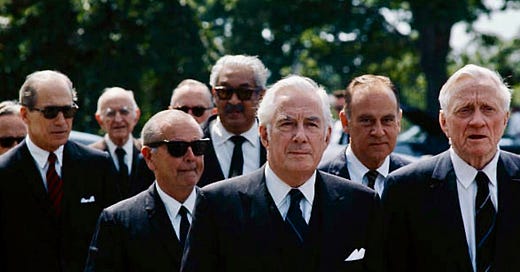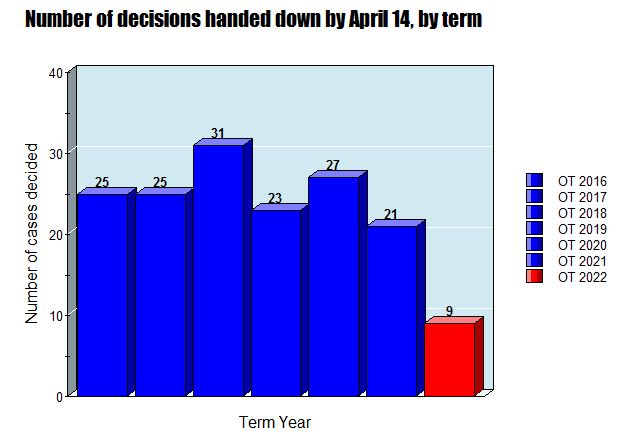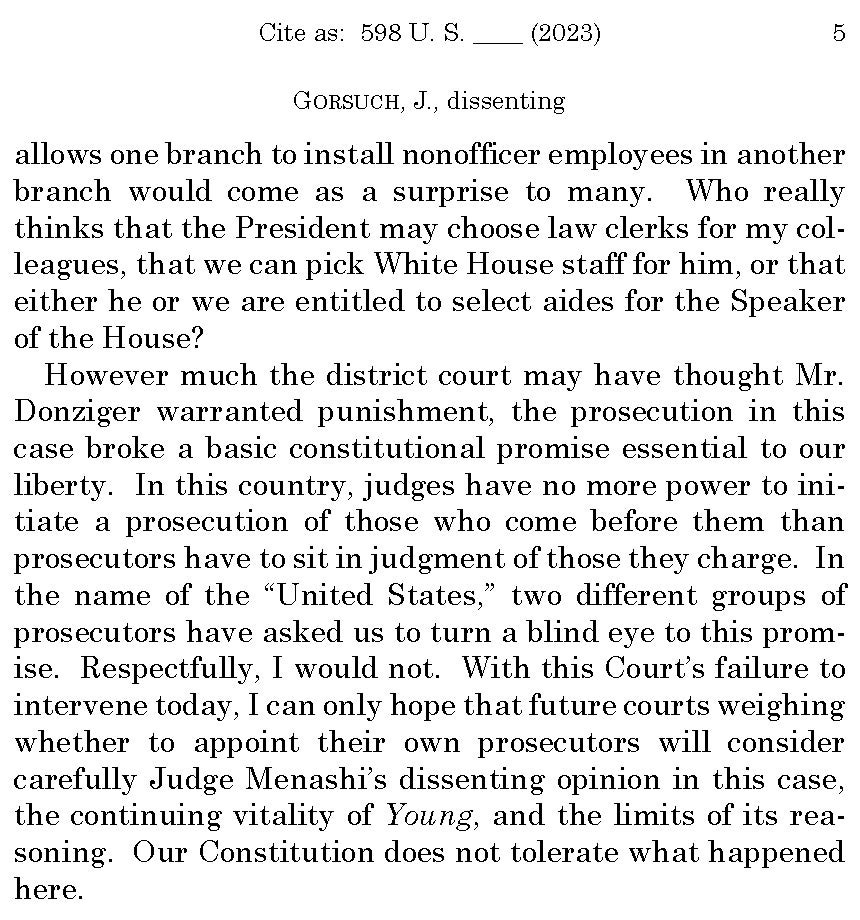21. United States v. Nixon
In July 1974, the Supreme Court effectively cleared the way for the ouster of a sitting President—in a ruling that may have ultimately *bolstered* the presidency as an institution
Welcome back to “One First,” a weekly newsletter that aims to make the U.S. Supreme Court more accessible to all of us.
Every Monday morning, I’ll be offering an update on goings-on at the Court; a longer introduction to the Court’s history, current work, or key players; and some Court-related trivia. If you’re enjoying the newsletter, I hope that you’ll consider sharing it (and subscribing if you don’t already):
On the Docket
Happy Halfway-Through-the-Term Day to all who celebrate! (The Court’s October 2022 Term began 26 weeks ago today; it ends 26 weeks from yesterday.)
The Supreme Court wrapped up the first half of the Term (and its March 2023 argument session) with a surprisingly quiet week. There was only a single decision by the Court in an argued case—with Justice Sotomayor writing for a 6-3 majority in Wilkins v. United States that the 12-year time bar for suing the United States under the Quiet Title Act is a “mandatory claim-processing rule,” rather than a jurisdictional bar (the principal significance of which is that it is subject to waiver or forfeiture). It’s a technical decision of limited significance, but that’s largely been what we’ve received so far this Term.
As Ian Millhiser noted on Twitter (the below graphic is his), the single ruling last week continues the remarkably slow pace of decisions in argued cases overall. Wilkins is only the ninth ruling in an argued case so far this Term (and one of those was a summary dismissal). With the Court not scheduled to release any additional rulings in argued cases until next Friday (April 14), that means that, even compared to the last three Terms (when the Justices heard the fewest merits cases since 1864), the Court is way behind in turning out decisions:
There are lots of potential explanations for this slowness. This is the first Term that the Court is using the new document security procedures that were apparently adopted in response to the Dobbs leak from last May; perhaps those are really gumming up the works. This Term was also especially front-loaded with high-profile merits cases, which might themselves be responsible for significant behind-the-scenes drama that is distracting the Justices from less divisive cases.1 But whatever the explanation, the paucity of merits decisions to this point in April (1) is yet another example of significant shifts in how the Court does its work that ought to be examined more carefully; and (2) augurs a very busy May and June for those who cover the Court.
Speaking of being behind, the Court granted only one new case for next Term in its Order List last Monday: A potentially important dispute about when “testers” have standing under the Americans With Disabilities Act. Meanwhile, perhaps the most visible denial of certiorari was in Donziger v. United States (in which I was counsel of record for the petitioner). Justices Gorsuch and Kavanaugh publicly dissented from the denial, with Kavanaugh joining in Gorsuch’s five-page opinion about why the Constitution doesn’t (and shouldn’t) tolerate judicial appointments of private special prosecutors to try criminal contempt of court offenses that DOJ has refused to prosecute. I’m quite biased, but I think Gorsuch’s dissent has the matter (and why the Court should have intervened) exactly right. And his last paragraph says everything about this case that I could’ve:
Turning to this week, we expect a regular Order List from the Court today at 9:30 EDT, but, again, no decisions in argued cases. And the Court still hasn’t ruled on West Virginia’s pending emergency application to put back into effect its ban on transgender women competing on women’s athletic teams at public schools. Given that the briefing on that application was completed on March 22 (12 days ago), the delay is quite … surprising. If nothing else, it certainly seems that someone is writing an opinion respecting whatever the disposition is. I’d say it’s likely that we get the ruling sometime this week, but I was fairly confident that we’d get it last week, too…
The One First Long Read: The Watergate Tapes
When I teach the Supreme Court’s July 1974 ruling in United States v. Nixon, I often begin (and later end) by asking my students who won and who lost. The latter question is easy; the unanimous opinion for an 8-0 majority2 by Chief Justice Warren Burger dealt a devastating blow to President Nixon—ordering him to turn over dozens of tapes of Oval Office recordings that had been subpoenaed by Watergate Special Prosecutor Leon Jaworski as part of his criminal prosecution of seven Nixon administration officials (a prosecution in which Nixon himself was named as an unindicted co-conspirator).
Nixon had begrudgingly turned over some of the tapes, but invoked “absolute executive privilege” to justify his refusal to turn over the others. On May 20, 1974, Judge John Sirica rejected Nixon’s arguments and ordered him to turn over the remaining tapes (or appeal by May 31). Nixon promptly appealed to the D.C. Circuit, and then both he and Jaworski asked the Supreme Court to grant a (then-unusual) writ of certiorari “before judgment”—leapfrogging the Court of Appeals and expediting review of the merits. On May 31, the Justices agreed—giving the parties 21 days to file their merits briefs; another 10 to respond; and scheduling oral argument for one week later, on Monday, July 8, 1974. Just 16 days later, the Court ruled against Nixon, and ordered him to fully comply with Jaworski’s subpoena.
One of those tapes, known to history as the “smoking gun” tape, was the direct catalyst for Nixon’s resignation; when its contents became public on Monday, August 5, Nixon’s remaining support among Republicans in Congress, in which the House was steadily moving toward his certain impeachment, evaporated. Three days later, Nixon announced his resignation; by noon that Friday, Vice President Ford had succeeded him. Indeed, it’s a straight line from the Justices’ July 24 ruling to the end of Nixon’s presidency. Thus, the conclusion that Nixon lost is inescapable.
But the question of who won is harder.
Part of the complication is that Chief Justice Burger’s opinion for the 8-0 majority is not exactly a model of analytical rigor. And part of it is that, in various places, the opinion reaches holdings that had (and continue to have) far-reaching ramifications well beyond Nixon’s plight.
First, Burger’s opinion was the first time that the Supreme Court ever expressly held that the President’s “executive privilege” is grounded in the Constitution itself (as opposed to recognizing the privilege as a common law protection inherent in the nature of the office). As Burger wrote,
Whatever the nature of the privilege of confidentiality of Presidential communications in the exercise of Art. II powers, the privilege can be said to derive from the supremacy of each branch within its own assigned area of constitutional duties. Certain powers and privileges flow from the nature of enumerated powers; the protection of the confidentiality of Presidential communications has similar constitutional underpinnings.
Thus, “to the extent [the President’s] interest [in confidentiality] relates to the effective discharge of a President’s powers, it is constitutionally based.” Of course, this holding was unnecessary; given that the Court ended up holding that the privilege was overcome in Nixon’s case, it could have assumed the constitutional nature of the privilege without formally embracing it. And yet, Nixon thus became a precedent (that still stands today) for the proposition that, whatever the proper scope of executive privilege, it derives from the Constitution itself—which means, among other things, that Congress cannot narrow it by statute.
Second, in explaining why executive privilege was only a “qualified” privilege (rather than the absolute one for which Nixon argued), Burger’s opinion also went out of its way to underscore the absolute nature of the “state secrets privilege,” which the Court had recognized in United States v. Reynolds in 1953 (a case with its own … dubious … backstory, which I plan to tell in a future issue). Although Reynolds had controversially held that courts couldn’t second-guess governmental assertions that particular evidentiary matters were state secrets (including, in that case, an accident report that contained no national security secrets, but that revealed that the cause of the crash was the military’s negligence), Nixon took it a step further—distinguishing the state secrets privilege as the kind of absolute privilege that, unlike executive privilege, could not be overcome. Again, this discussion was unnecessary to the result in Nixon—where the whole point was why executive privilege is different.
Finally, in explaining why Jaworski’s subpoena overcame Nixon’s executive privilege claim, the Court adopted a less-than-obvious view of the relevant constitutional interests. First, Burger wrote that “[t]he right to the production of all evidence at a criminal trial similarly has constitutional dimensions.” That’s just not true; there is no constitutional provision that creates a right to or requirement for “the production of all evidence at a criminal trial”; the Due Process Clause requires the production of potentially exculpatory evidence, but it would be strange indeed if it likewise required the production of inculpatory evidence.
Nevertheless, this framing was key to what followed. Again, quoting Burger’s majority opinion:
the allowance of the privilege to withhold evidence that is demonstrably relevant in a criminal trial would cut deeply into the guarantee of due process of law and gravely impair the basic function of the courts. A President’s acknowledged need for confidentiality in the communications of his office is general in nature, whereas the constitutional need for production of relevant evidence in a criminal proceeding is specific and central to the fair adjudication of a particular criminal case in the administration of justice.
This all sounds perfectly plausible, until we remember that it was the prosecutor, not the defendants, who had sought the subpoenaed tapes. It’s hard to understand how “the constitutional need for production of relevant evidence in a criminal proceeding” exists when it is the government seeking production of evidence against criminal defendants, rather than the other way around.
For decades, scholars and journalists have tried to piece together why the opinion of the Court in Nixon was such a mush—and why no Justice wrote separately. Some of this account figures prominently in The Brethren; and there are a veritable bevy of law review articles exploring the same topic (if from slightly more visible sources).
The consensus view, with which it is difficult to disagree, is that the Justices were absolutely intent on speaking with one voice, and were willing to abide a broad array of stylistic and substantive compromises in order to preserve their unanimity—much as the Court had in Brown v. Board of Education two decades earlier. Indeed, the chaotic 16 days between the argument and the issuance of the unanimous opinion nominally by Chief Justice Burger (who, as both Chief Justice and a Nixon appointee, felt like it was his duty to speak for the Court) witnessed a remarkable flurry of internal memoranda, discussions, and, in some cases, outright hijacking of the draft by different coalitions of Justices (especially some combination of Justices Brennan, Stewart, and White, who both individually and collectively contributed at least as much to the final draft as Burger). It’s quite a story from the perspective of the Court’s internal dynamics, but it’s also quite a story for what it yielded.
In the process, the Justices, whether wittingly or not, avoided the spectacle of a President being removed from office by the Senate for the first time in American history—by creating political conditions in which Nixon would’ve had no shot at acquittal. Of course, Nixon might have had no shot at acquittal even without the July 24 ruling. But there’s little question that the smoking gun tape—pried free by the Court’s intervention—was the final nail in the coffin.
But even if the denouement for Nixon was unwitting on the Justices’ part, the analytical flaws in Chief Justice Burger’s opinion for the Court and its overt endorsement of a constitutionally grounded executive privilege were (and would have been) impossible to miss. Thus, it is entirely possible to look back at the ruling in Nixon and conclude that the President lost but the presidency won. Paris, in that case at least, was worth a mass.
SCOTUS Trivia: Reservoir Justices
The already complicated deliberations in the Nixon case became further disrupted by what happened the day after oral argument. On July 9, 1974, former Chief Justice Earl Warren passed away at the age of 83. (As one of Warren’s biographers notes, although he had been hospitalized with a failing heart a week earlier, he died only after learning from Justices Douglas and Brennan that the Court had voted unanimously to rule against Nixon—his fellow Californian and longtime political enemy.)
Warren’s funeral was held at the National Cathedral two days later, and was attended by all nine Justices (and four retired Justices). Among lots of far more important things, it also prompted one of my favorite pictures of any group of Justices ever—one that Duke Professor Marin Levy has perfectly captioned “Reservoir Justices”:
You can see all nine Justices, along with retired Justice Tom Clark, in this image from Getty Images.
I hope that you’ve enjoyed this installment of “One First.” If you have feedback about today’s issue, or thoughts about future topics, please feel free to e-mail me. And if you liked it, please help spread the word!:
If you’re not already a paid subscriber and are interested in receiving regular bonus content (or, at the very least, in supporting the work that goes into this newsletter), please consider becoming one! This week’s bonus issue (the April installment of “Karen’s Corner”) will drop Thursday morning at 8 ET.
Happy Monday, everyone! I hope you have a great week.
In recent Terms, an additional explanation for the slower pace and smaller quantity of merits cases was the flurry of emergency applications—and interventions by the Justices on the “shadow docket.” But as I plan to discuss in a future post, the shadow docket has been much quieter thus far this Term; six months into the Term, the Court has granted two emergency applications (after granting 17 during the October 2021 Term and 24 during the October 2020 Term).
Justice Rehnquist did not participate in the case because of his close personal connection to three of the seven defendants under indictment, including former Attorney General John Mitchell.







I especially like that photo of CJ Warren's funeral because of Justice Stewart's strange expression behind CJ Burger's shoulder. I imagine him scheming The Brethren at the funeral.
As a 12 year-old political junkie at the time of the NIXON decision, i was pleased with its consequence of the President’s eventual resignation. Over the next four decades, I have come to appreciate Nixon’s complexity as a man and his accomplishments as President. Tom Wicker’s biography provided great assistance in my pathway.
All that context granted, as well as my support of President Ford’s pardon in September, however, does not excuse President Nixon’s damage to Americans accelerating mistrust in our institutions from the immediate post-1945 era. Since the NIXON decision and resignation, that mistrust has become, in my view, an increasing assumption of ineptitude, banality, and self-serving indifference from these institutions to those they once were perceived to be serving. The Vietnam escalation and its foundational lies, especially after our escalation in 1965, did enough damage, but even as President Ford spoke that “our Constitution works,” he said so in the aftermath of “our long national nightmare,” which is not “over,” but rather was unleashed on our politics, culture, and national sense of self. Thank you for your article, and I look forward to reading more from your publication.